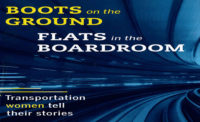 |
| Cho |
In a land of pink stucco, palms and countless bottles of water, scores of the nations top women transportation officialsand their male compatriotsgathered last month to talk business. The site was Phoenix, where appropriately enough highway and light rail construction plans are going like gangbusters.
In a somewhat over-air-conditioned Scottsdale conference room, Ann Warner, an official with Bechtel Infrastructure Group, predicted that states will likely have more access to GARVEE bonds, TIFIA loans, toll roads and public-private partnershipsaffectionately known as PPPwhen the transportation reauthorization bill finally passes. Language in the Senate bill will allow for extra money for the PPP approach and would clarify design-buildthere is confusion in the current bill about allowing the procurement process to move before the environmental impact statement, she noted.
Mary Peters, the chief of the Federal Highways Administration, later told the WTS assembly that flexibility is as important as the amount of money in the President Bush version of the bill. We have a 35% increase in Bushs billremember how happy we were with a 40% increase in TEA-21, she reminded.
PPP and increased use of technology are key to future transportation projects. Moreover, said Peters, it may be time to take another look at the role of the federal government in transportation. What she meant was that depending heavily on the gas tax to fund future construction of highways and transit may need to change. We need other ways to pay four these systems, she said. We need to diversity the portfolio. That means more PPP, toll roads, state infrastructure banks and other types of innovative finance. More Trans-Texas Corridors, Chicago Skyways and variably priced toll lanes are looming on the horizon.
Peters also encouraged the acceleration of innovations in construction practices and high-tech materials to build new bridges and highways faster. And she admitted, We in the public sector must not define to the nth degree what a project should look like. We are risk-adverse. After all, bad news equals front page news. Occasionally things dont go so well, but that should be okay. We should not make the private sector take all the risks. We should be more open to sharing the risk.
She received a standing ovation.
Then Gloria Jeff, a former deputy FHWA administrator and now head of the Michigan Dept. of Transportation, stood up to point out to her former colleague that utilizing new kinds of building materials for projects are more often than not far more costly than using the standard concrete and steel. We look forward to incentives from the feds, she said dryly, as the audience roared in appreciation at the friendly exchange between two powerful, charismatic women transportation leaderswith one who now represented the state sector.
A smiling Peters then mentioned that the House version contains $1 billion in seed money for a program that would encourage investigation of new materials to be put on an incentive list for states and municipalities to use in projects.
In a later session, Linda Bohlinger, senior vice president with HNTB, Kansas City, noted that states like Virginia and Georgia are looking at developing incentive fee concepts tied to value under PPP projects. This means the state can mandate performance goals for its private partners and make the developers work for their fees. For example, rather than getting a straight return on their investments, the developers might agree to a sliding scale of fees based on early completion dates.
Laurie Mahon, principal consultant with PB Consult, said there is a global standard emerging for financing projects. It boils down to.. looking at a need and trying to finance it, she said. In the U.S., we try to fit the need into the money that is given. Where the U.S. transportation industry is hung up on distinctions between public and private roles, its irrelevant abroadthere is a continuum of risk transfer among partners.
Having worked with the Panama Canal Authority on its hopes of building a $6-billion to $10-billion third set of locks and helping the London Underground to figure out how to spend $15 billion wisely, she observed, We tend to think of other countries as vacation spots, not as trading partners. But decisions in China, Europe, et cetera will have an impact on us. We in transportation can make a difference. For example, she said, railway engineering is the hardest job to fill in England for PBConsult. Yet we cant find enough for them to do in the U.S. U.S. expertise is in demand and exportable.


Post a comment to this article
Report Abusive Comment